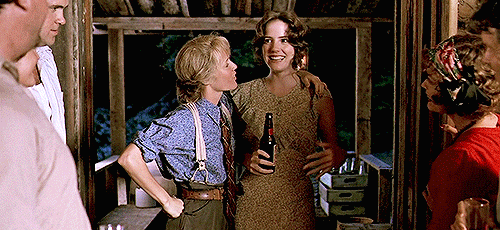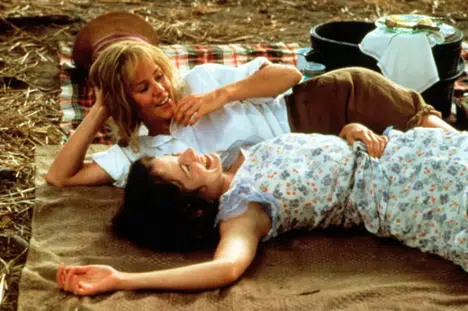
When Fried Green Tomatoes hit theaters in 1991, audiences expected a heartwarming tale of friendship, resilience, and Southern charm. What many didn’t expect was the undercurrent of a love story between two women, Idgie Threadgoode and Ruth Jamison. While Hollywood stopped short of labeling their relationship romantic, queer audiences saw themselves in the film’s subtext. Decades later, it’s celebrated as a lesbian classic a story that spoke in whispers but echoed loudly in LGBTQ+ culture.
The Book vs. The Movie: What Changed?
The movie was adapted from Fannie Flagg’s 1987 novel Fried Green Tomatoes at the Whistle Stop Café. In the book, Idgie and Ruth’s relationship is undeniably romantic. Flagg wrote them as life partners, raising a child together, defying norms, and building a family of their own.
Hollywood, however, softened the romance for mainstream audiences in the film adaptation. The queerness wasn’t erased entirely but transformed into subtext visible for those who knew where to look.
Queer Subtext and Why It Matters
Subtext has always been a lifeline for queer audiences. In eras when Hollywood wouldn’t allow openly gay relationships, viewers learned to read between the lines. A lingering look, a touch held too long, or the way characters chose each other against all odds these moments became signposts of queer love.
For Idgie and Ruth, their devotion transcends friendship. To queer audiences, the passion and commitment they share scream romance, even if the script never labels it that way.
Idgie Threadgoode: The Butch Heroine
Idgie is bold, rebellious, and unapologetically herself. With her tomboy style, love of the outdoors, and disdain for societal expectations, she embodies queer defiance. She doesn’t conform to the “proper Southern lady” mold, and audiences recognized her as a character who lived authentically even if Hollywood wouldn’t say the word “lesbian.”
Ruth Jamison: The Heart of the Story
Ruth, gentle yet strong, becomes Idgie’s anchor. Their relationship deepens when Ruth leaves her abusive marriage and finds safety in Idgie’s world. Together, they create a chosen family, running the Whistle Stop Café and raising Ruth’s son, Buddy Jr. It’s not just friendship—it’s partnership, love, and shared survival.

The Power of Chosen Family
One of the most compelling queer elements in Fried Green Tomatoes is its focus on chosen family. Idgie and Ruth build a life outside traditional structures, surrounding themselves with friends and community. For LGBTQ+ audiences many of whom have faced rejection from their families this message resonates deeply.
Food as a Symbol of Love
Food plays a huge role in the story, and it’s more than just Southern comfort cooking. Sharing meals at the Whistle Stop Café symbolizes care, intimacy, and belonging. Ruth and Idgie’s café becomes a safe space, much like queer bars and community hubs have been for LGBTQ+ people historically. Fried green tomatoes aren’t just food they’re love served on a plate.
Friendship or Romance? The Blurred Line
Some viewers still argue that Idgie and Ruth’s relationship was “just friendship.” But queer audiences know better. Historically, queer love has often been disguised as “intense friendship” because society wasn’t ready to acknowledge it. The blurred line in Fried Green Tomatoes reflects this cultural erasure and makes the subtext even more meaningful.
The Scene That Says It All
There’s one moment in particular that cements the romance for many fans. When Idgie feeds Ruth a honeycomb, the intimacy is undeniable. It’s tender, sensual, and filled with unspoken love. While not overtly sexual, it conveys everything a declaration of love would—without needing words.
Why Hollywood Shied Away From Explicit Queerness
In the early 1990s, mainstream Hollywood was still uneasy about LGBTQ+ representation. Studios worried about alienating audiences or facing backlash. As a result, films often relied on subtext instead of explicit storytelling. Fried Green Tomatoes walked this tightrope, giving queer viewers representation while staying “safe” for wider audiences.
The Impact on Lesbian Representation
Despite the lack of open acknowledgment, Fried Green Tomatoes was groundbreaking. At a time when few mainstream films centered women’s relationships let alone queer ones it gave audiences a love story that mattered. For many lesbians, Idgie and Ruth were the closest thing to representation they had in the early ’90s.
Why Queer Audiences Claimed It as Their Own
Representation doesn’t have to be explicit to resonate. Queer audiences have long learned to claim stories, characters, and moments as their own. Idgie and Ruth became queer icons not because Hollywood labeled them as such, but because their love was undeniable to anyone willing to see it.
The Film’s Legacy in Queer Culture
Over thirty years later, Fried Green Tomatoes still holds a special place in LGBTQ+ culture. It’s taught in queer film studies, celebrated at festivals, and referenced in discussions about representation. For many, it’s more than a movie—it’s a reminder of resilience, love, and the power of seeing yourself, even when society tries to erase you.
Why It Deserves the Title “Lesbian Classic”
So, is Fried Green Tomatoes really a lesbian classic? Absolutely. While the film never uses the word, the love between Idgie and Ruth is central, powerful, and undeniable. It’s a story of survival, devotion, and partnership that reflects queer realities of the time. For lesbians who saw themselves in Idgie and Ruth, it remains a touchstone of representation.
Conclusion: Love That Couldn’t Be Hidden
Fried Green Tomatoes may not have openly declared its queerness, but the love story between Idgie and Ruth lives on. It’s a film that queer audiences embraced, claimed, and celebrated as their own—a reminder that even in silence, love finds a way to be seen. And that’s why it deserves its place as a lesbian classic.
FAQs About “Fried Green Tomatoes” as a Lesbian Classic
1. Was Idgie really in love with Ruth in the movie?
Yes, though the film never says it outright, the depth of their bond strongly suggests romantic love.
2. Why didn’t Hollywood make the relationship explicit?
At the time, studios feared backlash and avoided openly queer storylines in mainstream films.
3. Is the book clearer about their relationship?
Absolutely. Fannie Flagg’s novel portrays Idgie and Ruth as life partners raising a child together.
4. Why is the honey scene considered important?
Because it’s intimate, tender, and symbolic of love—many fans see it as the film’s quiet love declaration.
5. How has the film influenced queer cinema?
It paved the way for discussions about representation and remains a beloved example of queer subtext in film.
